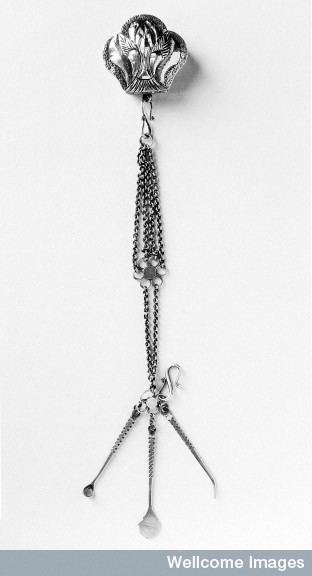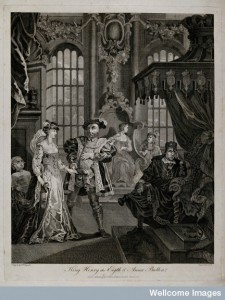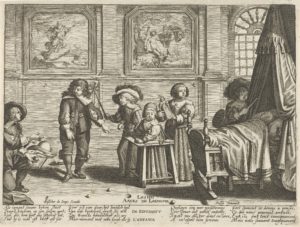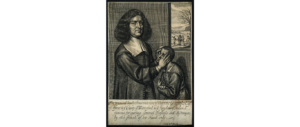
 During their courtship King Henry VIII gave Anne Boleyn a present of a pendant which contained a gold ‘ear scoop’ for cleaning wax from the ear. Some people make a lot of ear wax, or cerumen as it is known medically, which can cause problems with hearing but modern advice is not to insert anything into the ear canal to try to remove wax manually as this can make the problem much worse. Therefore Anne’s gift would be frowned on by modern medicine.
During their courtship King Henry VIII gave Anne Boleyn a present of a pendant which contained a gold ‘ear scoop’ for cleaning wax from the ear. Some people make a lot of ear wax, or cerumen as it is known medically, which can cause problems with hearing but modern advice is not to insert anything into the ear canal to try to remove wax manually as this can make the problem much worse. Therefore Anne’s gift would be frowned on by modern medicine.

According to the NHS Direct website
“Earwax is produced inside your ears to keep them clean and free of germs. It usually passes out of the ears harmlessly, but sometimes too much can build up and block the ears”.1
Ysbrand van Diemerbroeck’s anatomy textbook described the anatomy of the ear and how in the ear canal ‘some yellow choleric, bitter, thick, viscous Humors happen to be gathered together, resembling the softer sort of Wax, by the Ancients call’d Cerumina’.2 This book didn’t expand upon the origins or purpose of earwax, but one early modern explanation for origin of cerumen was that it was ‘that bilious humor [called] by the vulgar English, the eare-wax (or gluttinous expurgation of the brain’ which was made ‘for the inviscation of the Auricularia Earewig, and other small insects’ or to stop small creatures from crawling down your ear canal.3 Scipion Dupleix book of curiosities addressed the reasons why earwax tastes bitter
“It comes from a putrified and corrupt humour, which gathered together, thickens and heats there within, and being such, can bee no other then bitter; as are all things overcocted and rotten”
And agreed that it was still a useful substance because
“this humour neverthelesse is not unprofitable within the eares, but being thickned, fleas, and other little flyes which may insinuate within the eares, may trouble us, are there taken by this conglutinate humour”.4
The idea that earwigs were particularly attracted to the ear crevices is an old folk lore. According to the OED the name is similar in many European languages such as German, Dutch and French.5 We have looked at creepy crawlies in the ears and on the body in a previous post.
As if protecting your body from insects wasn’t enough, earwax was also thought to have therapeutic qualities. A translation of the French author Peter Bovistau Launay, argued that:
I will conclude with this that there is nothing in him [the body], either joynt or member how despicable soever it be, which is not proper for some use, profitable to some end, and from which may not be extracted some singular Medicine, Remedy and benefit; as Gallen and many other Physitians do affirme […] the eare- wax applyed to the nostrills provoketh to drousinesse and sleep.6
Another medical guide explained that “Ear-wax is a present remedy for the Colick, if it be taken in drink”.7 Oswald Croll claimed that an unbeatable balsam to stop wounds from becoming infected was manufactured by getting
“As much ear-wax as can be got, add it to Oyl of Wallnuts made by expression, boyle them together, untill with gentle heat, the Oyl be somewhat thick like a Balsome. The use of this is wonderful in most speedy curing all wounds, for it excellently consolidates, and perfectly frees from putrefaction”.8
Alternatively, one could make use of the qualities of ear wax as a straight forward moisturiser. In the sixteenth century, medic Andrew Boorde described a recipe for enhancing the nails, but wrote that if you couldn’t find the ingredients you could simply use ear wax on the nails.9
Extracted ear wax from animals was also thought by some to have some therapeutic qualities. For example, the ear wax from a dog was apparently considered useful for bringing down a fever. The book falsely ascribed to medieval Albertus Magnus states that:
“Architas sayth, yf the waxe of the left eare of a dogge be taken, and be hanged uppon men syck in the fevers that come by cours or fyttes, it is verye profitable, and specially to the fever quartayne”.10
Ear wax was also used in other ways. John Bate’s The Mysteryes of Nature recommended adding earwax to size when applying metals to certain paints to eliminate bubbles.11
These examples show just some of the ingenious uses early modern people found for earwax.
______________________________
[1] http://www.nhs.uk/conditions/Earwax/Pages/Introduction.aspx
[2] The Anatomy of Human Bodies (1694), p. 465.
[3] Anthropologie Abstracted: or The idea of Humane Nature Reflected (1655), pp. 140-41.
[4] The Resolver; or Curiosities of Nature written in French by Scipio Du Plesis (1635).
[5] www.oed.com: ‘earwig’: ‘The belief that the earwig has a habit of crawling into the human ear, although apparently unfounded, is a long-standing and widespread one. It is recorded in English sources from the Old English period and is reflected in names for the insect in many languages’.
[6] The Theatre of the World (1663), p. 52.
[7] Théophile Bonet, A Guide to the Practical Physician (1686), p. 106.
[8] Oswald Croll, Bazilica Chymica, & Praxis Chymiatricae (1670), p. 186.
[9] Andrew Boorde, The Breuiarie of Health (1587).
[10] The Boke of Secretes of Albertus Magnus (1560), p. 66.
[11] The Mysteryes of Nature (1634).



Earwax was also used, apparently, as a sort of rosin on stringed instruments.
Interesting! We will have to keep an eye out for that.
Ear wax applied to the nostrils promotes sleep? Haha I’ll be sure to try that next time when I can’t nod off.